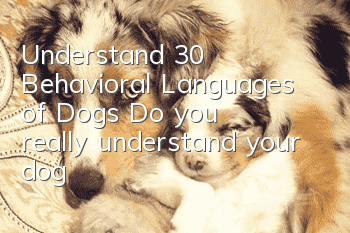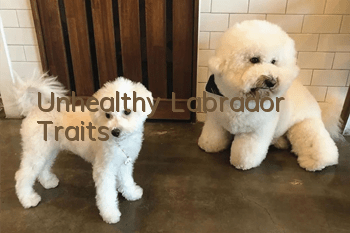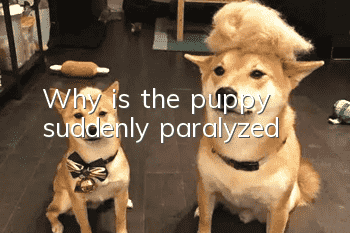Understand 30 Behavioral Languages of Dogs Do you really understand your dog?

Understand 30 behavioral languages of dogs
1. Happy: Dogs swing their tails vigorously and jump to high places. This is the most common way of expression.2. "Smile": The nose is full of wrinkles, the upper lip is pulled open to expose the teeth, the eyes are slightly closed, the gaze is gentle, the ears are stretched back, the mouth is slightly opened, a humming sound is made in the nose, and the body is gentle The ground is twisted, the coat on the whole body is smooth and not erected, the tail is wagging lightly, and it is close to people (but remember, wagging the tail does not always mean happiness).
3. Anger: The nose is lifted, the upper lip is pulled apart, teeth are exposed, eyes are wide open, sharp gaze, ears straight back and diagonally; generally the mouth is not opened, making a threatening sound, and stamping hard Four legs, body stiff, fur erect, tail straight out, keeping a certain distance from people. If the forelimbs are lowered and the body is sitting back, it indicates that an attack is imminent.
4. If the dog doesn't like you, it will first turn its back to you, then walk away, and then make threatening sounds, and if you approach it, it will resist.
5. Sadness: head drooped, eyes dull, moving closer to the owner, and looking at the owner with pleading eyes, sometimes lying in a corner and becoming extremely quiet.
6. Fear: The tail hangs down or is sandwiched between the legs, the ears stretch back, the fur on the whole body stands upright, the eyes are wide open, the whole body is trembling, standing still or the limbs move or retreat uneasily.
7. Waiting: Wagging the tail, standing calmly, and looking directly at the owner, this is also a sign of expectation.
8. Awe: The head is drooped, the ears are close together, and the body is low. This is also a sign of submission.
9. Get close to people: The tail is stretched high and swings, the ears are erect, the head is swinging, the body is arched, and sometimes the front paws are extended. This is also a request to play with people.
10. Apologize: When the owner blames the dog, the dog does not know what happened, but only knows that the owner is angry, so it will turn its belly to express an apology.
11. Obedience: Puppies will treat people as adult dogs, so they will also show their awe by exposing their bellies.
12. Acting like a baby: Adult dogs will show that they are as small as babies by showing people their belly; female dogs under six months of age will often "flash pee", which is actually a form of acting like a baby. Performance.
13. Surrender: When dogs meet the same kind for the first time, dogs with lower status will reveal their belly when they see dogs with higher status. This means that even if the other party is full of anger, it will calm down.
14. Heartbeat: When a dog meets the opposite sex he likes, his tail will stand up at a right angle and vibrate slightly.
15. Angry: When a dog is angry, its tail will droop. 16. Happy: When a dog feels happy, its tail will swing from side to side.
17. Fear: When a dog is afraid, it will tuck its tail between its legs.
18. Sickness: When a dog is sick, his tail will hang loosely.
19.Hound: If it is a hound, when it smells prey, its tail will be extended straight out, pointing in the direction of the prey.
20. The whole body is stiff, the hair on the back is standing up, and the voice is growling: Be more sensible! Don’t push me too hard!
21. Yawn: I am so nervous.
22. Raise your nose, bare your teeth and roar in a threatening manner: I have reached the limit of my endurance, don’t be unhappy.
23. Lie down in front and raise your back: Let’s play a game!
24. Roll in front of you: I will listen to you in everything.
25. Breathing heavily: possibly angry.
26. Joy: beating constantly, bending the body, stepping on the ground with its front legs, swaying its tail vigorously from side to side, and twisting its ears back. Large dogs may also raise their front legs to lick the owner's face and make a bright "bark" sound.
27. Pleasure: Slowly wag its tail, make a slight "whimpering" sound in its throat, and sometimes lick the owner's hands and face continuously.
28. Act coquettishly: Use your nose to make a "hehe" sound. When asking for forgiveness from its owner and acting coquettishly, it will droop its tail. When it wants something or wants its owner to play with it, it will gently wag its tail.
29. Anger: The whole body is stiff, the limbs are stretched out, the dog's hair is standing on end, and the lips are rolled up, teeth are exposed, and a threatening "beep" sound is made. The tail will flick slightly and the ears will stand upright towards each other.
30. Sadness: It makes "coo-coo" and "ho-ho" calls, lowers its tail, and rubs its owner's body in a call for help.
Random articles
- What should you pay attention to after deworming your dog?
- Will it really kill people if a dog imitates a wolf's barking?
- How to gain weight if Teddy is too thin?
- Can dogs understand people talking? The answer may surprise you
- How much does a golden retriever cost? Analysis of prices of various golden retriever products
- Why does the Zhou dog not die when it comes to dog dealers? The truth is heartbreaking...
- What to eat if your dog’s hair is dry and dull? Feed more of these hair-beautifying foods!
- How long does it take for Big Pampering to take effect? Will it be affected by the dog’s physical condition?
- What can gray Teddy eat to make it easier for him to lose color? Have you memorized the food choices for gray Teddy to change color?
- Dog’s Anal Gland Inflammation Inflammation of the anal glands needs to be treated promptly!



